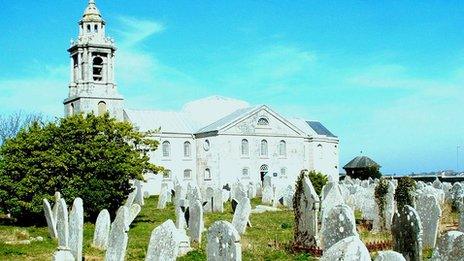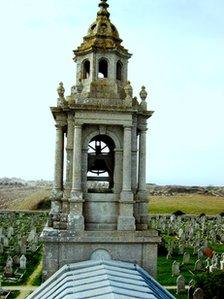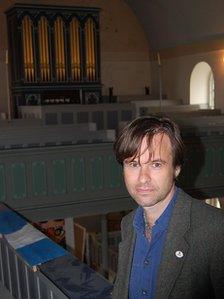St George's Reforne church restored to former glory
- Published

The Churches Conservation Trust has overseen an £800,000 restoration of St George's Reforne in Portland
A church near Portland has been restored thanks to an £800,000 conservation scheme.
High above the cliff tops of the Isle of Portland's West Bay sits St George's Reforne church.

Architect Thomas Gilbert built the church in the 18th Century
Its mystery and intrigue become ever more compelling when the sea mist rolls in and shrouds it in cloud.
St George's is a church that has been on a difficult journey. Among those buried in its graveyard include survivors of the Titanic, massacred victims of the Royal Navy's press gang and a man whose house fell down on top of him.
But, finally St George's looks to be heading back to its rightful place as a valued community asset.
Visitors flocking
Dwindling congregations and accumulating repairs meant that in 1971, The Churches Conservation Trust first took possession of St George's when still known as The Redundant Churches Fund.
Today, following five months of restoration work, visitors are flocking to enjoy the rejuvenated building.
Dr Neil Rushton, conservation manager with The Churches Restoration Trust (CCT), admits it has been a journey of discovery.
He said: "There's been some valuable support to get this project off the ground and through to what we see today.
"Something in the region of £800,000 has been spent on repairs, but there have been elements of that work which have also been separately funded."

Dr Neil Rushton inside St George's with its restored organ behind him
Wessex Archaeology carried out a full archaeological survey of the 18th Century building.
Soldiers returning from active service have also been involved in the restoration.
A small number played their part as members of Wessex Archaeology's initiative Operation Nightingale, where servicemen are training in the latest techniques as a form of rehabilitation.
Dr Rushton added: "Architecturally, this is also an extremely unusual church.
"Thomas Gilbert in the mid-18th Century was attempting to mimic St Paul's Cathedral in London in terms of design.
"The flattened dome as it ended up, either because he ran out of money or couldn't get it right, is extremely difficult to maintain in terms of guarding against water intrusion, so that's what's taken up the bulk of the project."
Despite the church's resurrection, sadly its complete restoration is still to be realised.
Another £500,000 is required to fund more vital repairs in the next five years.
To bridge that funding gap, the CCT hope to take advantage of an active local community, including hosting local art exhibitions such as Pop Up Dorset.
Students from nearby Royal Manor Arts College are playing an active role, exhibiting their own artwork and carrying architectural surveys.
The hope is more visitors and more initiatives will secure the church's long-term sustainability.